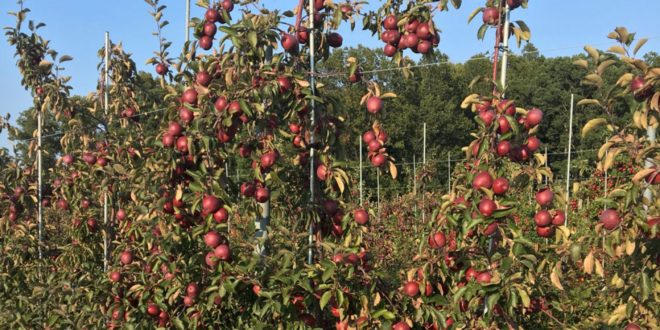
Feb 8, 2021Oregon State establishes demonstration orchard for growing cider industry
Oregon’s cider industry is growing rapidly and the state is emerging as a national leader in craft cider production. Currently, the Pacific Northwest is home to one-quarter of the nation’s cider-makers. Interestingly, most of the cider in today’s marketplace is made from dessert or culinary apples – such as Fuji, Jonagold and Red Delicious.
Although good cider can be produced from these apples, heirloom and hard cider apple varieties are preferred to make truly great and complex cider. As with wine, the unique characteristics of the variety – coupled with high fruit quality – is essential for creating a superior quality product.
To help meet the needs of this rapidly growing industry, Nik Wiman, OSU’s orchard crops Extension specialist, and his team of researchers established a 3-acre research and demonstration cider orchard at the North Willamette Research and Extension Center in Aurora.
The orchard has more than 80 apple varieties – some that are well-known in the industry and in high demand by cider-makers – plus other lesser known or experimental varieties needing to be evaluated under western Oregon conditions. The orchard is being used to evaluate varieties and production practices that can increase yield while reducing costs. This is essential information to help the industry grow and reach more consumers.
In addition to performance, fruit quality and quantity and insect and disease resistant, Wiman’s research also delves into evaluating how an open orchard design and training will affect cider apple economics.
Commercial fresh market apple production has moved away from low-density, free-standing trees to high-density orchards that have 1,000 or more trees per acre with highly dwarfing rootstocks that require trellis support. The latter requires a lot of upfront cost and labor and it remains unclear how well that model works for cider fruit production, Wiman said. More likely, the U.K. model of cider apple production with free-standing trees and a relatively low number of trees per acre is a more profitable model for Oregon growers, or something in between.
In the future, Wiman plans to evaluate mechanized harvesting systems in trellis and free-standing sections of the orchard for a more efficient and less expensive way of picking fruit.
– Nik Wiman, Oregon State University














